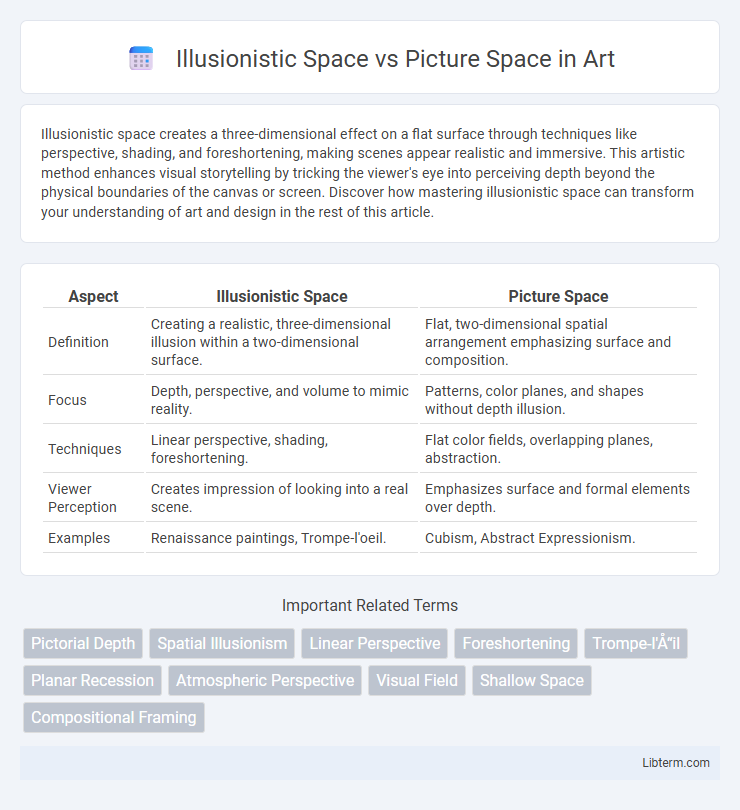Illusionistic space creates a three-dimensional effect on a flat surface through techniques like perspective, shading, and foreshortening, making scenes appear realistic and immersive. This artistic method enhances visual storytelling by tricking the viewer's eye into perceiving depth beyond the physical boundaries of the canvas or screen. Discover how mastering illusionistic space can transform your understanding of art and design in the rest of this article.
Table of Comparison
| Aspect | Illusionistic Space | Picture Space |
|---|---|---|
| Definition | Creating a realistic, three-dimensional illusion within a two-dimensional surface. | Flat, two-dimensional spatial arrangement emphasizing surface and composition. |
| Focus | Depth, perspective, and volume to mimic reality. | Patterns, color planes, and shapes without depth illusion. |
| Techniques | Linear perspective, shading, foreshortening. | Flat color fields, overlapping planes, abstraction. |
| Viewer Perception | Creates impression of looking into a real scene. | Emphasizes surface and formal elements over depth. |
| Examples | Renaissance paintings, Trompe-l'oeil. | Cubism, Abstract Expressionism. |
Defining Illusionistic Space and Picture Space
Illusionistic space refers to the artistic technique that creates the perception of three-dimensional depth on a two-dimensional surface, often employing perspective, shading, and color gradients to mimic real-world spatial relationships. Picture space, on the other hand, denotes the actual flat plane of the artwork, bounded by its physical dimensions and devoid of any implied depth, emphasizing the artwork's two-dimensionality. Understanding the distinction between illusionistic space and picture space is crucial for analyzing how artists manipulate visual elements to either simulate reality or highlight the inherent flatness of the medium.
Historical Evolution of Artistic Spaces
The historical evolution of artistic spaces distinguishes illusionistic space, which emerged during the Renaissance with techniques like linear perspective to create depth and realism on a two-dimensional plane, from picture space, traditionally characterized by flat, symbolic representations in medieval and Byzantine art. Illusionistic space revolutionized visual storytelling by simulating three-dimensional environments, allowing artists to manipulate spatial perception and enhance narrative immersion. This shift reflects broader cultural transformations, emphasizing humanism and empirical observation that defined Western art's progression from symbolic to naturalistic representation.
Key Principles of Illusionistic Space
Illusionistic space in art relies on key principles such as linear perspective, chiaroscuro, and foreshortening to create the appearance of three-dimensional depth on a two-dimensional surface. Through precise manipulation of light, shadow, and proportion, artists simulate spatial relationships that trick the viewer's eye into perceiving realistic depth. This contrasts with picture space, which emphasizes the flatness of the canvas and often rejects depth to focus on surface, color, and form.
Characteristics of Picture Space in Art
Picture space in art is characterized by its flat, two-dimensional surface where depth is implied rather than physically present. It relies on compositional elements like color, line, and shape to organize visual information within a defined boundary. The use of shallow depth or overlapping forms emphasizes the picture plane, maintaining the artwork's inherent flatness while guiding the viewer's perception.
Techniques for Creating Illusionistic Space
Techniques for creating illusionistic space include linear perspective, which uses converging lines to simulate depth on a flat surface, and atmospheric perspective, where color and clarity diminish with distance to mimic natural vision. Foreshortening shortens objects along the line of sight, enhancing the sense of three-dimensionality within a picture space. Chiaroscuro employs strong contrasts of light and shadow to give volume and realistic depth, reinforcing the illusion of spatial depth in two-dimensional art.
The Role of Perspective in Both Spaces
Illusionistic space utilizes linear perspective to create the appearance of depth on a flat surface, guiding the viewer's eye into a convincingly modeled three-dimensional environment. Picture space, however, often embraces a more ambiguous or flattened perspective, emphasizing the two-dimensionality of the canvas and the surface qualities of the artwork itself. The role of perspective in illusionistic space is to replicate real-world optics, while in picture space it challenges or subverts traditional spatial conventions, affecting perception and artistic interpretation.
Notable Artists and Examples
Illusionistic space, characterized by lifelike, three-dimensional representation on a flat surface, is masterfully demonstrated in works by artists like Leonardo da Vinci and Andrea Mantegna, whose frescoes, such as Mantegna's "The Camera degli Sposi," create convincing architectural depth. Picture space, emphasizing the flatness of the canvas while organizing elements through compositional techniques, is evident in the works of Piet Mondrian and Kazimir Malevich, who explored abstract spatial arrangements in paintings like Mondrian's "Composition with Red Blue and Yellow." These distinctions highlight the evolution of spatial representation from Renaissance naturalism to modern abstraction.
Visual Perception and Viewer Engagement
Illusionistic space relies on creating a realistic depth that tricks visual perception, enhancing viewer engagement through the simulation of three-dimensionality on a flat surface. Picture space emphasizes the flatness of the canvas, prompting viewers to engage with the artwork's surface qualities and the arrangement of shapes and colors. This contrast influences how viewers interpret spatial relationships and emotional depth within the artwork.
Contemporary Interpretations and Approaches
Contemporary interpretations of illusionistic space expand beyond traditional linear perspective, incorporating digital technologies and mixed media to blur boundaries between flat picture space and immersive environments. Artists manipulate scale, depth cues, and materiality to challenge viewers' spatial perception, often integrating augmented reality or virtual reality elements for dynamic interaction. These approaches emphasize an experiential dimension where picture space becomes a fluid, interactive plane rather than a static window into illusionistic depth.
Impact on Modern Visual Art and Design
Illusionistic space transforms two-dimensional surfaces into convincing three-dimensional illusions, profoundly influencing modern visual art by enhancing realism and depth perception in paintings and digital designs. Picture space, emphasizing the flatness of the surface, drives contemporary artists and designers to explore abstraction and surface texture, challenging traditional perspectives and encouraging innovative composition techniques. These contrasting approaches shape modern art's dynamic engagement with spatial representation, pushing boundaries in visual storytelling and design aesthetics.
Illusionistic Space Infographic

 libterm.com
libterm.com